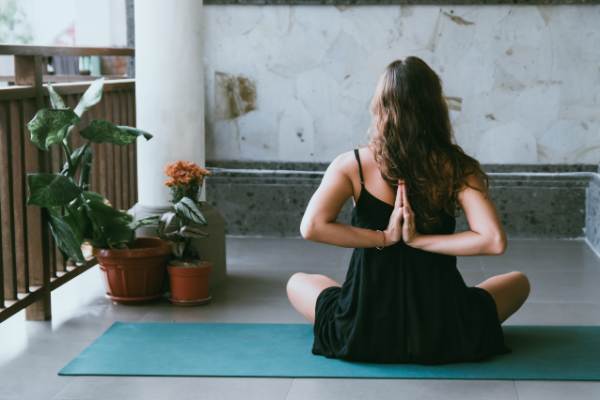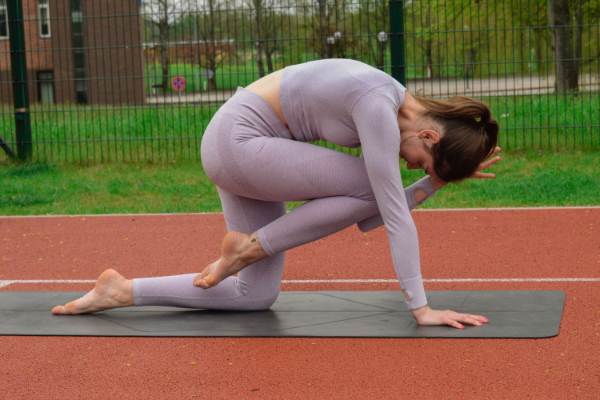Due to yoga’s numerous medical advantages, many patients elect to continue practicing it after knee replacement surgery.
If you are recovering from knee replacement surgery and would like to start or keep practicing yoga, you should be aware of many poses and modifications that can help with the general healing process.
How Yoga After Knee Replacement Can Help
Your knees play a crucial role in the overall motion and movement of your body. Surgery for knee replacement is frequently performed to replace a diseased joint with an artificial one.
A lot of recovery time is needed because it’s a serious procedure. The knee joint may be fragile after this kind of surgery because most patients have limited flexion and swelling around the knee.
In order to support your knee replacement, yoga practice can help you regain your sense of balance, gain new insight into the knee area, and strengthen the surrounding muscles and joints.
Yoga Poses For Knee Replacement
Warrior Two
A yoga lunge poses known as “Warrior Two” can tone the quadriceps. This is crucial because you want to strengthen the muscles that support the knee joint.
Start by standing in Mountain Pose: stand tall with both feet about hip distance apart. (if you require a wall, chair, walker, etc. to aid in maintaining your posture, please feel free to use one.)
Step the right foot back to create a wide stance while maintaining the working foot rooted (let’s say it is the left leg).
Maintaining a left knee bend while maintaining a toe-pointing position for your knee. Keep your right leg as straight as you can without locking the knee.

Turn your right foot just enough outward as you step it back to keep it in line with your right knee and create a solid foundation.
You don’t want to put more strain on your left knee, so try to keep your center of gravity at your pelvis. Align your left knee over the ankle bone or heel as you progress into this lunge.
Again, too much pressure on the joint will result from having the knee aligned too far forward.
Finally, you can position your left thigh just above parallel with the floor. This should create enough tension in your quadriceps and hamstrings to keep your pose stable.
Tree Pose
This balance-enhancing standing position will speed up the healing of your knee replacement. You might want to stand close to a wall or a high-backed chair because you’ll be standing on one foot, as this will help your posture.
Place both of your feet firmly on the ground while standing with your working side closest to the wall (let’s start with the left side).
To engage your thigh muscles, slowly transfer your weight to your left foot and plant firmly.
As you exhale, contract your abdominal muscles to engage your core. Once you’re secure, raise your right foot off the floor.
To keep this lifted leg moving, it is advised that you flex this foot. Spinning the raised knee outward 45 degrees is sufficient for this pose.
Put the foot inside the leg that is supporting you while standing. Keep the position for ten to twenty breaths.
Once finished, repeat the position on the opposite side.
Bridge Pose
Laying on your back will help you get into position. With your feet firmly planted on the ground, stoop to your knees.
Your knees should ideally be placed directly over your ankle bones. However, take a small step forward with both feet if the recovering knee does not yet have that range of motion.
Step your feet out farther on your yoga mat as necessary, making sure that your toes and knees are pointing in the same general direction.
When you eventually assume the posture, this will give you a wider range of motion and keep your knee joints in a safe alignment.
If you want more stability and leverage, you might try practicing this pose with your toes up against a wall.
Lift your hips into the air as you exhale, then maintain this position for ten to twenty breaths. All the leg muscles around your knee joints will be used as you lift and support yourself.
Child Pose
Get on your hands and knees to begin. For knee protection, use a folded blanket. Between your legs or along your calves, place a large cushion or yoga bolster.
Extend your arms forward onto the ground as you slowly recline back onto the cushion. Your forehead can rest on the ground or another soft surface.
You might not be able to sit back all the way onto your heels, depending on the range of motion in your knees.
Keep your hips raised as high as necessary while using your cushion as support, until you can relax into the posture without discomfort.
Hold this position for as long as you can. In order to calm your body and mind, concentrate on taking slow, deep breaths.
Savasana
After any yoga practice, you may finish in Savasana. Just take a few minutes to relax your entire body by lying on your back on your yoga mat.
But sometimes it’s not entirely comfortable to lay on your back with your legs out in front of you. For complete physical and mental comfort, you might need some additional support.
A pillow, bolster, or blanket that has been rolled up might be placed beneath your knees. Your lower back will also be relaxed, allowing you to have a comfortable night’s sleep.
To help your body and mind relax, take a few deep breaths in and out.
Tips
When doing yoga after knee replacement, proceed with caution and restraint. Prior to incorporating yoga into your recovery, make sure your doctor gives you the go-ahead.
You should also hold off on starting a new practice until your knee has fully recovered from the initial surgery.
Tell your yoga instructor about your surgery if you attend a formal class or studio so that she can recommend modifications and poses that won’t cause your knee to get hurt again.
Transferring from one pose to another requires caution. If you move into a different pose while feeling safe and at ease in one, you might lose your balance.
Throughout your practice, keep a few accessible balance aids, such as a chair or wall, close at hand.
Avert pivoting poses and asanas that call for holding prolonged deep knee bends.
